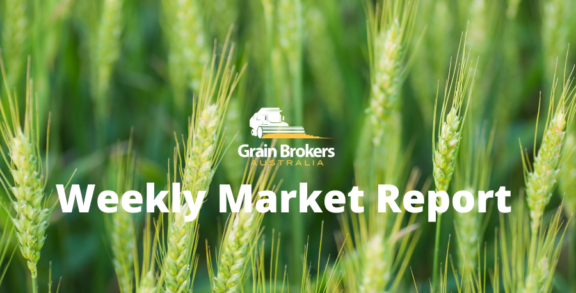
Wheat still ‘Russian’ out the ports …
Grain Brokers Australia > Weekly Wire
by Peter McMeekin
The price and pace of Russian wheat exports combined with the further uncertainty regarding export restrictions continued to be the dominant influence on global wheat futures markets over the past week.
The market opened sharply down last Tuesday following the long weekend in the United States (US). This was followed by two more negative days and a very subdued session on Friday that was basically unchanged. However, the market rallied strongly in the first trading session this week, as the trade positioned itself ahead of the next United States Department of Agriculture (USDA) report which is due to be released on Wednesday.
According to reports out of Russia, wheat exports in the first quarter of the marketing year (July to September) will be close to 14 million metric tonnes (MMT). This continues to prevent incremental export demand moving to other origins such as the US. This fact was certainly reflected in the most recent US export figures.
The latest Egyptian (GASC) wheat tender lineup also echoed the dominance of the Russian exporters with 660 thousand metric tonnes (KMT) offered and all were Black Sea origin, 600KMT of Russian and 60KMT of Romanian. GASC picked off the low hanging fruit by booking one cheap cargo of Russian that was offered at US$6-8 below the other sellers.
It seems that the ‘fake news’ phenomenon is not confined to the US. Early last week wires were reporting another about-face in Russian wheat export policy. This followed a meeting between the government and exporters that had supposedly resulted in a decisive “no export restriction” statement from the government.
However, people present at the meeting are advising that no such statement was made, and the government will continue to monitor all export data, port stems and exporter programs. Nonetheless, it seems that the US futures markets are trading the ‘fake news’ as opposed to the ‘real news’ at the moment.
The Russian export uncertainty is creating a highly volatile global futures environment which is distorting the global market and driving the urgency for Russian exporters to ship grain as quickly as possible. This will add to the global rationing required in the first half of 2019 as the availability of export stocks decreases.
Another piece of news the market seems to have been ignored in recent weeks is the size of the Canadian wheat crop. Stats Canada pegged it at 29MMT, as opposed to the United States Department of Agriculture forecast of 32.5MMT. This would put Canadian wheat production down 1MMT year-on-year.
The story is similar here in Australia where the wheat crop is getting smaller despite suggestions that Western Australia (WA) may harvest upwards of 11MMT. The Queensland and New South Wales crops will struggle to be much over 2.2MMT. The Victorian crop is probably around 2.2MMT with the Mallee region deteriorating fast. I have seen some South Australian crop forecasts as high as 4MMT, but my scouts suggest it is more like 2.9MMT. If we call WA 10.5MMT for now, that comes to 17.8MMT nationally.
Downward revisions to both the Canadian and Australia wheat crops and some global demand rationing is certainly expected when the USDA releases their updated numbers later this week.
In Argentina, the rumoured export tax has finally been confirmed by the Macri government. To the surprise of the market, the authorities opted for a pro rata tax rate of 4 pesos per US dollar (USD), as opposed to the expected flat rate of 10 per cent. At the current exchange rate of around 37 pesos per USD, the tax is very close to 10 per cent. The challenge for the market is that the tax is tied to the exchange rate and consequently, it will fluctuate on a daily basis.
Uncertainty around how the tax will work and how it will be administered has put the market in a state of disarray. The Argentinian farmers are notorious for holding their production as a hedge against inflation. This will only be exacerbated if they expect the peso to weaken against the USD. Not what the government wants, as a weakening peso will generate lower export tax income.
On the flip side, the Argentinian farmers have commenced planting their summer crop, and this will require working capital. October is the peak planting month for corn and November is the peak month for soybeans. With interest rates at 60 per cent (yes, 60), the banks will not be knocked down in the rush for crop finance. Farmers will more likely liquidate old crop stocks to fund the new crop program as and when required.
Back to the Russian situation. Nobody really knows the true supply and demand equation in a country with a very fragmented market, inefficient logistics and quite opaque market intelligence. We know that production was down from last year and we know exports will have to be lower. How much will be consumed domestically is a huge variable and will ultimately determine the exportable surplus.
Meanwhile, wheat will keep ‘Russian’ out the ports until lack of supply or export restrictions stem the tide.





